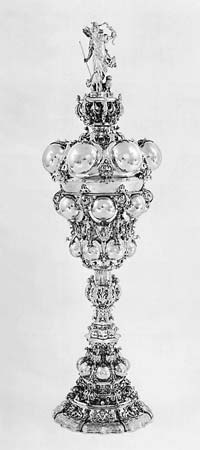Museum of Decorative Arts
museum, Berlin, Germany
German Kunstgewerbemuseum
 museum in Berlin housing an important collection of applied arts and crafts. The museum, among the oldest of its kind in Germany, displays both historical and contemporary pieces.
museum in Berlin housing an important collection of applied arts and crafts. The museum, among the oldest of its kind in Germany, displays both historical and contemporary pieces.The museum was founded in 1868 as the Deutsches-Gewerbe-Museum zu Berlin—the name by which it was known until 1879. After a series of moves and a temporary name change, in 1985 the main collection found its current home in a newly built structure in Berlin's Kulturforum at Potsdamer Platz. In 2004 the museum opened a second site, located in the 17th-century Baroque Köpenick Palace.
The museum's Kulturforum location has some 75,000 square feet (7,000 square metres) of exhibition space, organized to demonstrate the historical evolution of the decorative arts and industrial design. Its holdings include costumes, wainscoting, furniture, glass and metalwork, silks (silk), and other objects of distinct craftsmanship or heritage and represent every major period and style. The earliest pieces date to the Middle Ages; they include the famous gold and silver work seen in the reliquaries and liturgical items that constitute the Guelph Treasure (Welfenschatz), along with such objects as the baptismal font of Emperor Barbarossa. Other pieces made of Venetian glass and fine earthenware reveal the opulence of the Italian aristocracy during the Renaissance. Baroque furniture, faience work of European courts, and tableware and accessories from various historical periods are also represented. The museum's collection of 20th-century pieces showcases industrial as well as hand-crafted objects, with items from the Bauhaus school and furniture designed by Charles and Ray Eames (Eames, Charles; and Eames, Ray).
The Köpenick Palace location contains decorative arts from the 16th, 17th, and 18th centuries and includes paneling, tapestries (tapestry), and enamelwork.
- 5e duc de Noailles, Jean-Paul-François
- 5e prince de Condé, Henri-Jules de Bourbon
- 5th Baron Chandos, Grey Brydges
- 5th Baronet Burdett, Sir Francis
- 5th Baronet Sitwell, Sir Osbert
- 5th Baron Willoughby, Francis Willoughby
- 5th duke of Bedford, Francis Russell
- 5th earl of Bothwell, Francis Stewart Hepburn
- 5th earl of Glencairn, Alexander Cunningham
- 5th earl of Rosebery, Archibald Philip Primrose
- 5th Earl of Warwick, Richard Beauchamp
- 5th Lord Seton, George Seton
- 5th marquess of Lansdowne, Henry Charles Keith Petty-Fitzmaurice
- 5th Viscount Howe, William Howe
- 60 Minutes
- 61 Cygni
- 6e duc de Bourbon, Jean II
- 6e duc de Broglie, Maurice
- 6th Baron Byron, George Gordon Byron
- 6th Baronet Acton, Sir John Francis Edward
- 6th Baronet Cayley, Sir George
- 6th Baronet Mosley, Sir Oswald
- 6th Baronet Sitwell, Sir Sacheverell
- 6th Baronet Sykes, Sir Mark
- 6th Earl of Angus, Archibald Douglas